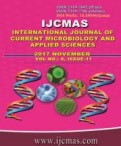


 National Academy of Agricultural Sciences (NAAS)
National Academy of Agricultural Sciences (NAAS)

|
PRINT ISSN : 2319-7692
Online ISSN : 2319-7706 Issues : 12 per year Publisher : Excellent Publishers Email : editorijcmas@gmail.com / submit@ijcmas.com Editor-in-chief: Dr.M.Prakash Index Copernicus ICV 2018: 95.39 NAAS RATING 2020: 5.38 |
A field experiment was carried out during winter and summer seasons of 2012-13 and 2013-14 at the Lower Gangetic Plain of West Bengal to evaluate the impact of mulching on yield and water use efficiency (WUE) of forage crops. The experiment was composed of three different perennial forage crops (Brachiaria brizantha, Panicum maximum and Setaria anceps), kept in the main plots. The sub-plots consisted of three mulches (no mulching, soil dust mulching and live mulching). Forage crop Setaria anceps gave highest green forage yield (GFY) in both seasons. GFY increased by 12.36 to 24.63% in winter season and 11.39 to 20.99% in summer season with live mulching treatment as compared to soil dust mulching and no mulching. Dry matter yield was also increased by 6.74 to 14.66% in winter season and 6.31 to 15.98% in summer season with live mulching treatment as compared to others mulch management. WUE was assessed in terms of both green (WUEGF) and dry biomass (WUEDF).Both of these were found highest with Setaria anceps during both seasons. The magnitude of WUE was lowest under no mulching condition followed by soil dust mulching and it was highest with live mulching in both seasons. The mean value of WUEGF increased by 6.62 to 23.85% in winter season and 7.37 to 15.94% in summer season with live mulching; whereas WUEDF increased by 1.36 to 13.93% in winter season and 4.46 to 13.33% in summer season with live mulching as compared to others mulch management. Considering both yield and water use efficiency farmers of the adjoining areas can be advised to cultivate forage crop Setaria anceps with live mulching practice.
 |
 |
 |
 |
 |